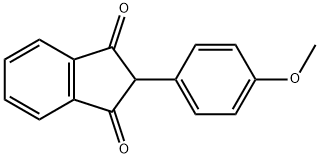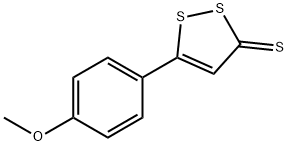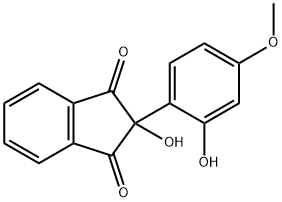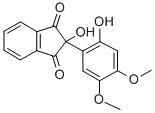2-P-ANISYL-1,3-INDANDIONE
- CAS NO.:117-37-3
- Empirical Formula: C16H12O3
- Molecular Weight: 252.26
- MDL number: MFCD00176194
- EINECS: 204-186-6
- SAFETY DATA SHEET (SDS)
- Update Date: 2024-11-20 11:41:24

What is 2-P-ANISYL-1,3-INDANDIONE?
Absorption
Accumulation does not occur with repeated dosing.
Toxicity
An overdose is likely to cause abnormal bleeding, for which the symptoms include: bleeding from gums or nose, blood in urine or stools, excessive bleeding from minor cuts, patches of discoloration or bruises on the skin.
Chemical properties
Slightly beige or yellow powder
Originator
Miradon,Schering,US,1960
The Uses of 2-P-ANISYL-1,3-INDANDIONE
radiopaque agent
The Uses of 2-P-ANISYL-1,3-INDANDIONE
Anisindione is a synthetic anticoagulant that prevents the formation of active procoagulation factors and proteins in the liver.
Background
Anisindione is a synthetic anticoagulant and an indanedione derivative. Its anticoagulant action is mediated through the inhibition of the vitamin K-mediated gamma-carboxylation of precursor proteins that are critical in forming the formation of active procoagulation factors II, VII, IX, and X, as well as the anticoagulant proteins C and S, in the liver.
Indications
For the prophylaxis and treatment of venous thrombosis and its extension, the treatment of atrial fibrillation with embolization, the prophylaxis and treatment of pulmonary embolism, and as an adjunct in the treatment of coronary occlusion.
Definition
ChEBI: A cyclic beta-diketone consisting of indane-1,3-dione having a 4-methoxyphenyl substituent at the 4-position.
Manufacturing Process
To a hot solution of 20.6 g of sodium in 400 ml of absolute ethanol, there is added a solution of 110 g of phthalide and 110 g of p-methoxybenzaldehyde. A vigorous reaction ensues and one-half of the alcohol is distilled off over a two hour period. Ice and water are added to the red solution and the diluted solution is acidified with hydrochloric acid. The resulting gum solidifies and the aqueous phase is removed by decantation. The crude solid is recrystallized twice from two liters of ethanol yielding 2-(p-methoxyphenyl)-1,3-indandione as pale yellow crystals, MP 155-156°C.
brand name
Miradon (Schering).
Therapeutic Function
Anticoagulant
General Description
Anisindione, 2-(p-methoxyphenyl)-1,3-indandione, 2-(p-anisyl)-1,3-indandione (Miradon), is ap-methoxy congener of phenindione. It is a white, crystallinepowder, slightly soluble in water, tasteless, and absorbedwell after oral administration.
In instances when the urine may be alkaline, an orangecolor may be detected. This is caused by metabolic productsof anisindione and is not hematuria.
Pharmacokinetics
Anisindione is a synthetic anticoagulant and an indanedione derivative. It is prescribed only if you cannot take coumarin-type anticoagulants such as coumadin as anisindione is a powerful drug with serious potential side effects. Anticoagulants decrease the clotting ability of the blood and therefore help to prevent harmful clots from forming in the blood vessels. These medicines are sometimes called blood thinners, although they do not actually thin the blood. They also will not dissolve clots that already have formed, but they may prevent the clots from becoming larger and causing more serious problems.
Metabolism
Not Available
Purification Methods
Crystallise anisidinone from acetic acid or EtOH. [Horeau & Jacqius Bull Soc Chim Fr 53 1948, Koelsch J Am Chem. Soc 58 1331 1936, Beilstein 8 III 2931.]
Properties of 2-P-ANISYL-1,3-INDANDIONE
| Melting point: | 156-157° |
| Boiling point: | 355.44°C (rough estimate) |
| Density | 1.1824 (rough estimate) |
| refractive index | 1.5600 (estimate) |
| storage temp. | Sealed in dry,Room Temperature |
| solubility | Chloroform (Slightly) |
| form | Solid |
| pka | pKa 4.13(H2O t=25.0±0.1 I=0.1(NaCl)) (Uncertain) |
| color | White to Off-White |
| EPA Substance Registry System | Anisindione (117-37-3) |
Safety information for 2-P-ANISYL-1,3-INDANDIONE
| Signal word | Warning |
| Pictogram(s) |
 Exclamation Mark Irritant GHS07  Health Hazard GHS08 |
| GHS Hazard Statements |
H302:Acute toxicity,oral H351:Carcinogenicity |
| Precautionary Statement Codes |
P264:Wash hands thoroughly after handling. P264:Wash skin thouroughly after handling. P270:Do not eat, drink or smoke when using this product. P308+P313:IF exposed or concerned: Get medical advice/attention. P501:Dispose of contents/container to..… |
Computed Descriptors for 2-P-ANISYL-1,3-INDANDIONE
New Products
4-AMINO-TETRAHYDRO-PYRAN-4-CARBOXYLIC ACID HCL 4-(Dimethylamino)tetrahydro-2H-pyran-4-carbonitrile 4-Aminotetrahydropyran-4-carbonitrile Hydrochloride (R)-3-Aminobutanenitrile Hydrochloride 3-((Dimethylamino)methyl)-5-methylhexan-2-one oxalate 1,4-Dioxa-8-azaspiro[4.5]decane 5-Bromo-2-nitropyridine Nimesulide BP Aceclofenac IP/BP/EP Diclofenac Sodium IP/BP/EP/USP Mefenamic Acid IP/BP/EP/USP Ornidazole IP Diclofenac Potassium THOMAIND PAPER PH 2.0 TO 4.5 1 BOX BUFFER CAPSULE PH 9.2 - 10 CAP SODIUM CHLORIDE 0.1N CVS ALLOXAN MONOHYDRATE 98% PLATINUM 0.5% ON 3 MM ALUMINA PELLETS (TYPE 73) LITHIUM AAS SOLUTION 2-Bromo-1-(bromomethyl)-3-chloro-5-nitrobenzene 2-Bromo-3-nitroaniline N-(3-Hydroxypropyl)-N-methylacetamide 3-Bromo-6-chloropyridazine 4-ethyl-3-nitrobenzoic acidRelated products of tetrahydrofuran








You may like
-
 1-Methyl-6-oxo-1,6-dihydropyridazine-3-carbonitrile 98%View Details
1-Methyl-6-oxo-1,6-dihydropyridazine-3-carbonitrile 98%View Details
99903-60-3 -
 88491-46-7 98%View Details
88491-46-7 98%View Details
88491-46-7 -
 1823368-42-8 98%View Details
1823368-42-8 98%View Details
1823368-42-8 -
 2-(3-(tert-butyl)phenoxy)-2-methylpropanoic acid 1307449-08-6 98%View Details
2-(3-(tert-butyl)phenoxy)-2-methylpropanoic acid 1307449-08-6 98%View Details
1307449-08-6 -
 Ethyl 3-(furan-2-yl)-3-hydroxypropanoate 25408-95-1 98%View Details
Ethyl 3-(furan-2-yl)-3-hydroxypropanoate 25408-95-1 98%View Details
25408-95-1 -
 2-Chloro-5-fluoro-1-methoxy-3-methylbenzene 98%View Details
2-Chloro-5-fluoro-1-methoxy-3-methylbenzene 98%View Details
1805639-70-6 -
 1784294-80-9 98%View Details
1784294-80-9 98%View Details
1784294-80-9 -
 Lithium ClavulanateView Details
Lithium ClavulanateView Details
61177-44-4